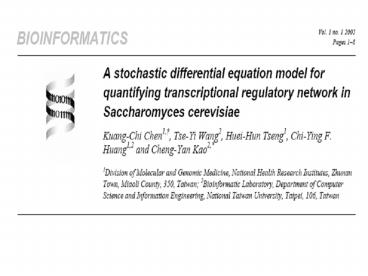Transcriptional Regulatory Network - PowerPoint PPT Presentation
1 / 24
Title:
Transcriptional Regulatory Network
Description:
With the use of SDE, it enables not only transform linear differential equation ... regulatory function of a specific regulator i is described as a sigmoid function : ... – PowerPoint PPT presentation
Number of Views:56
Avg rating:3.0/5.0
Title: Transcriptional Regulatory Network
1
Transcriptional Regulatory Network
- A Stochastic Differential Equation (SDE) Model
for Quantifying Transcriptional Regulatory
Network in Saccharomyces cerevisiae
2
Goal
- In systems biology or genetic network, four
models are widely used Linear Differential
Equation, S System, Boolean Network and Bayesian
Network. - Goal Apply stochastic differential equation
(SDE) to model the dynamic stochastic patterns in
genetic network? - With the use of SDE, it enables not only
transform linear differential equation model into
statistical model, but also combine with Bayesian
network to be applied to small sample problem in
our future work? - Our SDE model is basic but the test results agree
very well with the observed dynamic expression
patterns.
3
e.g. S System
- Dynamics of biological systems at the level of
pools of molecular species can be described
mathematically by the S-system as follows (Voit,
2000) (power function) - where X is n-dimensional components or pools, the
parameter vector p consists of rate constants, aj
and ßj , and kinetic orders, gij and hij . f is
the set of net rate equations, which consists of
the influxes and the effluxes. The m-dimensional
independent variables in the S-system equations
are expressed as Xnj , j 1, . . . ,m.
4
Dynamic Stochastic Model (1/4)
- Let Nt denote the exact amount of target gene
mRNA at time t. - From time t to t?t, the dynamic transcription
and degradation process is - (Nt?t Nt )/Nt ?Nt / Nt
- (gt ?) ?t et,?t
- where gt is the transcription rate, ? is the
degradation rate, et,?t is the noise or random
error captured by normal distribution N(0,s2?t).
5
Dynamic Stochastic Model (2/4)
- Let ?t ? 0, we have the SDE as follows,
- where Wt is the standard Brownian motion, which
represents the source of uncertainty of random
error, and s is the fluctuation.
6
Dynamic Stochastic Model (3/4)
- Since Nt could not be directly measured, we
measure the signal intensity St instead, which is
proportional to Nt. - Let Xt log(St B) be the expression level of
the gene, where B is the background intensity. - Without loss of generality, we might assume that
Xt logNt.
7
Dynamic Stochastic Model (4/4)
- From Itô rule, we have
-
(1) - where XtlogNt denotes the expression level of
the gene, - P.S. In Chen, et al. (2004) Bioinfomatics,
their model is as follows
8
Regulatory Functions (1/2)
- At time t, the transcription rate gt of the
target gene depends on the n regulators through
regulatory functions. - Let Xit be the expression level of the i-th
regulator at time t. The regulatory function of a
specific regulator i is described as a sigmoid
function -
(2) - where the mean and s.d. are estimated by
and
9
Regulatory Functions (2/2)
- Let
(3) - Combing equations (1) and (3), we have
- where c0 c0 -?/2 s2/2, and ci is the
contribution of regulator i to the
transcriptional regulatory network.
10
Statistical Method (1/2)
- From time tj to tj1, j1,2,,m, we have
- where i1,2,,n denote the n regulators, fi
is the regulatory functions and Ztj are i.i.d.
normally distributed. - For the m samples at time tj, j1,2,,m
11
Statistical Method (2/2)
- where
- is observed, and s are unknown
but can be - estimated by simple linear regression.
- But in Chen et al. (2004), Y is unknown and the
statistical inference is incomplete.
12
Computational Approach
- Initially for n1.
- For a given gene, choose the regulator with
the highest log likelihood value from the
candidate regulator pool. - For nn1.
- Choose the new one when it combines with the
former regulators can achieve the highest log
likelihood. - For each n, calculate the AIC value.
- If AIC starts to increase, stop and the
former regulators are the ones we want.
13
Result
- Result.1,2
- http//www.csie.ntu.edu.tw/b89x035/yeast/
14
Result
- Result.3,4
15
Result
- Result.5,6
16
Result
- Result.best.1,2
17
Result
- Result.best.3
18
Result
- Result.worst
19
Result
- Result.worst
20
Twenty specific target genes
Table 1. Twenty specific target genes with
corresponding putative regulators and associated
regulatory abilities
21
Ten best-fitting target genes
Table 2. (a) Ten best-fitting target genes with
corresponding putative regulators and associated
regulatory abilities
22
Ten worst-fitting target genes
(b) Ten worst-fitting target genes with
corresponding putative regulators and associated
regulatory abilities
23
The statistical summary of regulators of the SDE
mode
24
Future Work
- Associate with Bayesian Networks to apply in the
small sample analysis. - Add the nonlinear terms to model the cross
interaction. - Add the exponential terms to model the powers
law, e.g. associate with S system. - When it comes to the phase change, we can add the
Boolean functions, State space models (SSMs).































